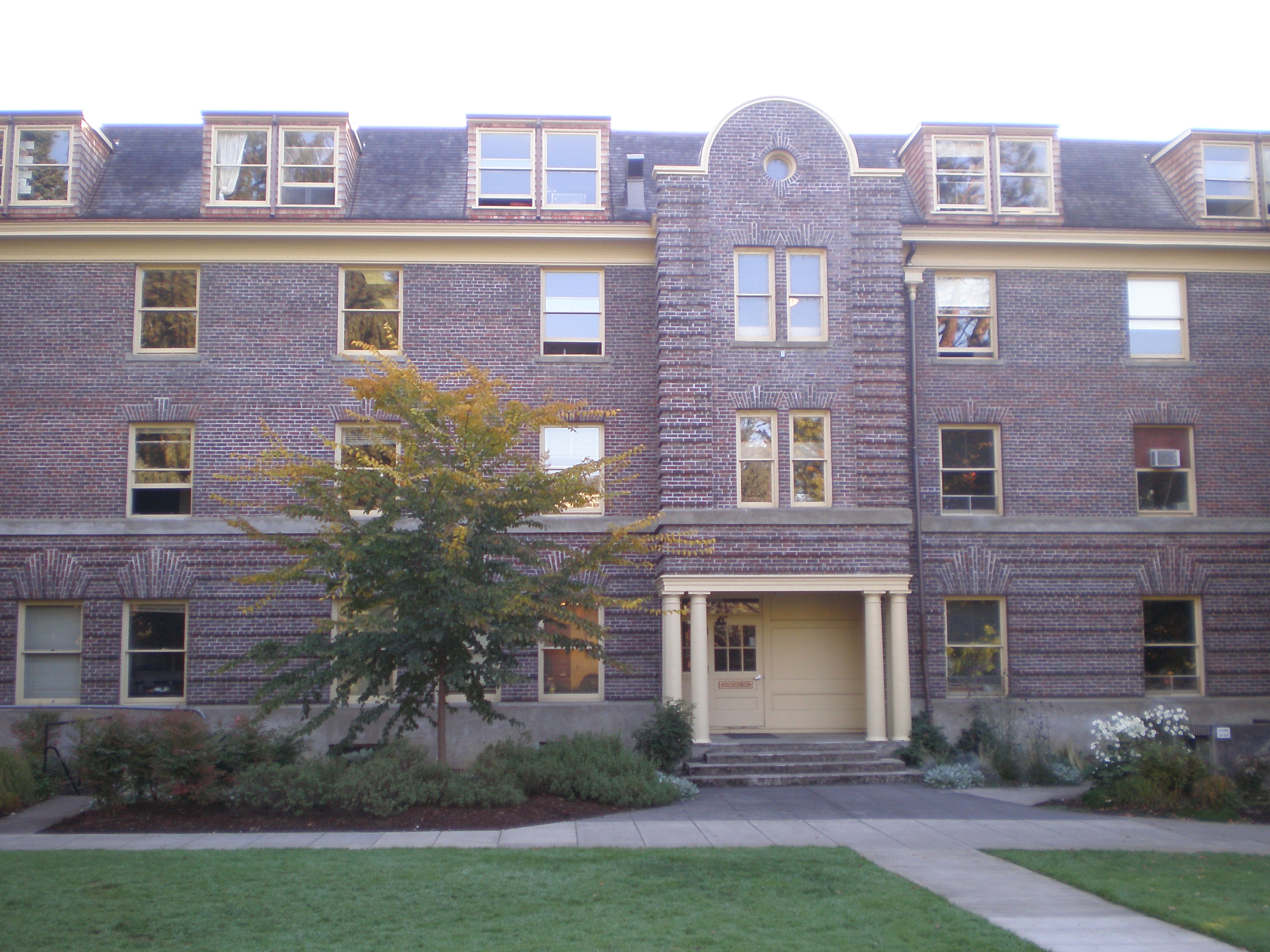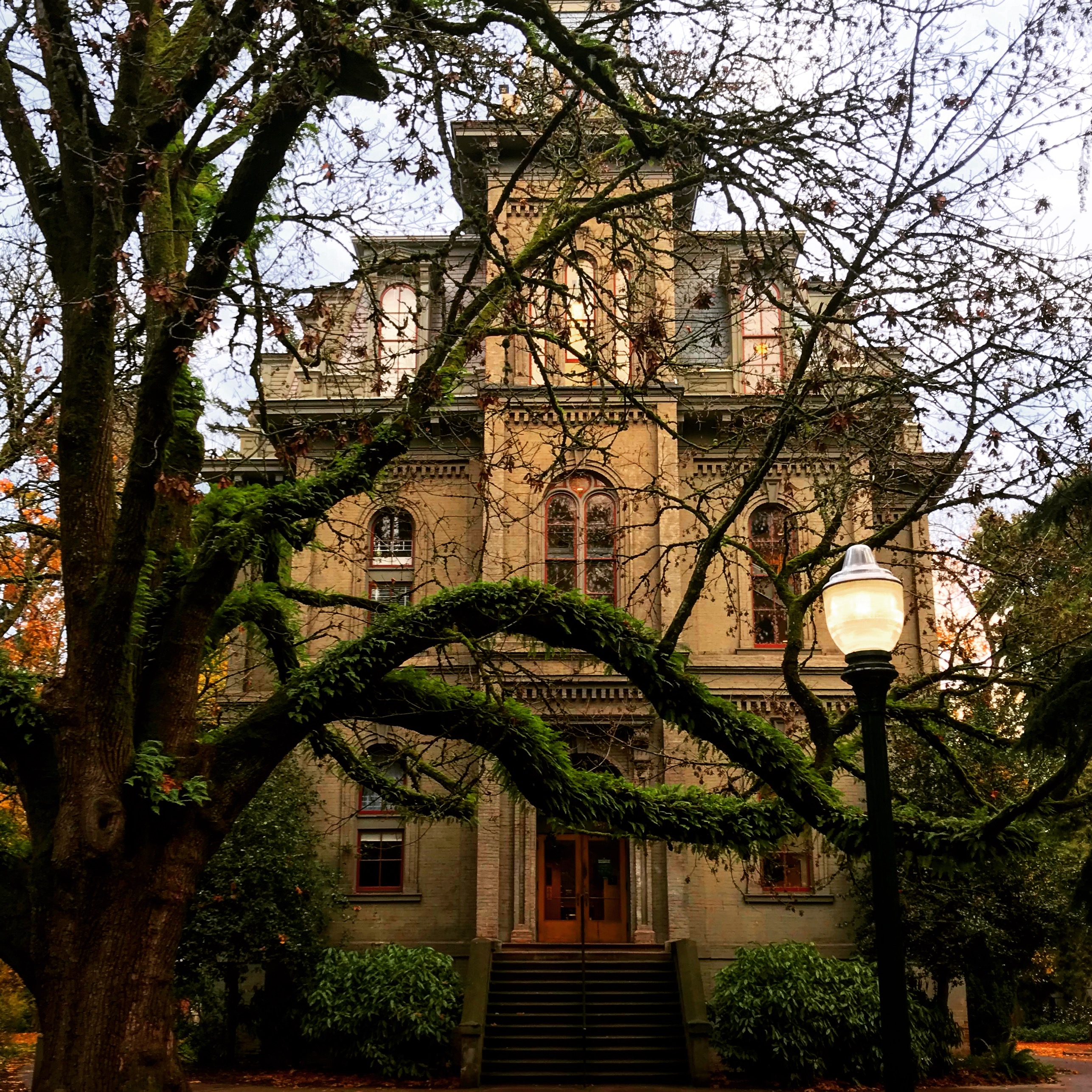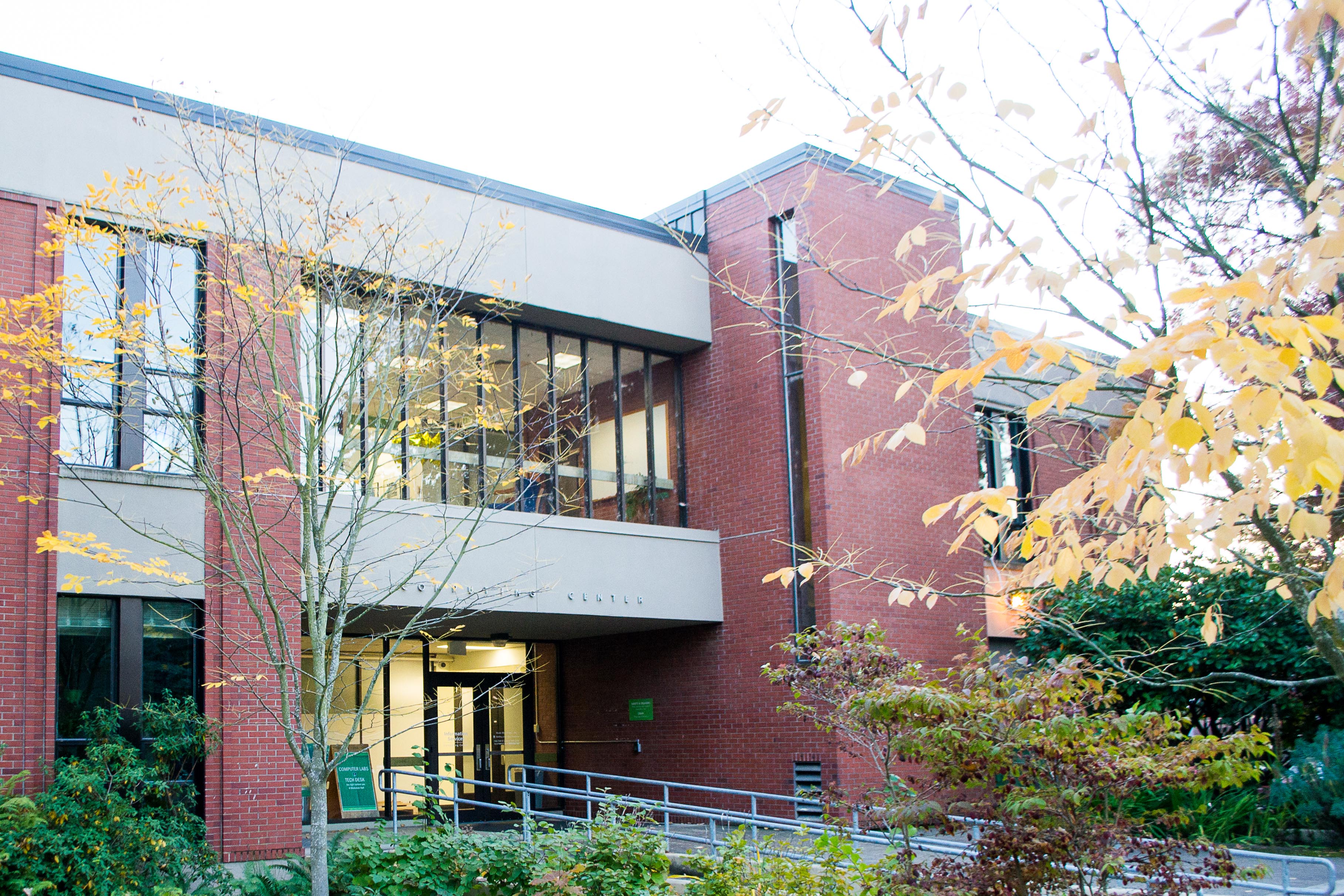|
Friendly Hall
Friendly Hall, built in 1893, is a three-story, red-brick masonry building located on the University of Oregon campus in Eugene, Oregon, United States. Description Friendly Hall overlooks the old campus quad, which dates to the founding of the university in 1876 and which includes some of the oldest and most historically significant buildings on campus, including Deady Hall (1876), Villard Hall (1886) and Fenton Hall (1906). The building was named for Samson Friendly, a Eugene merchant, Eugene city mayor (1893–95) and a member of the Union University Association, which established the university. History The building was designed in a Jacobean style by the renowned Portland architectural firm Whidden & Lewis Whidden & Lewis was an architectural firm based in Portland, Oregon, in the United States, around the beginning of the 20th century, formed by William M. Whidden and Ion Lewis. The partnership was established in 1889. Their residential building ..., who devised many of ... [...More Info...] [...Related Items...] OR: [Wikipedia] [Google] [Baidu] |
Friendly Hall, University Of Oregon 2011
Friendly may refer to: Places * Friendly, West Yorkshire, a settlement in Calderdale, West Yorkshire, England * Friendly, Maryland, an unincorporated community in the United States * Friendly, Eugene, Oregon, a neighborhood in the United States * Friendly, West Virginia, a town in the United States * Friendly Islands or Tonga Other uses * Friendly (surname) * Friendly (musician), Australian-born musician * Friendly (sport) or exhibition game, a game of association football or bandy that has no consequence in a wider competition * Friendly's, an American restaurant chain * Friendly Center, a shopping mall in Greensboro, North Carolina, United States * Friendly Hall, a building on the University of Oregon campus * Friendly High School, a public high school in Fort Washington, Maryland, United States * Friendly number, in mathematics, shares a property concerning its divisors * Friendly TV, a British TV station from 2003 to 2010 See also * Friend (other) * Friendly Hills ... [...More Info...] [...Related Items...] OR: [Wikipedia] [Google] [Baidu] |
University Of Oregon Campus
The campus of the University of Oregon is located in Eugene, Oregon and includes some 80 buildings and facilities, including athletics facilities such as Hayward Field, which was the site of the 2008 Olympic Track and Field Trials, and McArthur Court, and off-campus sites such as nearby Autzen Stadium and the Riverfront Research Park. An online guide to the university's built environmentArchitecture of the University of Oregon published by the University of Oregon Libraries, describes campus buildings and provides timelines of key architectural events linked with campus history. History Inception Era (1876–1913) The campus opened in Eugene on October 16, 1876, in an 18-acre former wheat field purchased from Reverend J. H. D. Henderson. Henderson's land had been part of Hilyard Shaw's original donation land claim. Work on the first campus building, named Deady Hall in 1893, would not yet be completed until 1877, and school began on the building's first floor with hammerin ... [...More Info...] [...Related Items...] OR: [Wikipedia] [Google] [Baidu] |
Eugene, Oregon
Eugene ( ) is a city in the U.S. state of Oregon. It is located at the southern end of the Willamette Valley, near the confluence of the McKenzie and Willamette rivers, about east of the Oregon Coast. As of the 2020 United States Census, Eugene had a population of 176,654 and covers city area of 44.21 sq mi (114.50 sq km). Eugene is the seat of Lane County and the state's second largest city after Portland. The Eugene-Springfield metropolitan statistical area is the 146th largest in the United States and the third largest in the state, behind those of Portland and Salem. In 2022, Eugene's population was estimated to have reached 179,887. Eugene is home to the University of Oregon, Bushnell University, and Lane Community College. The city is noted for its natural environment, recreational opportunities (especially bicycling, running/ jogging, rafting, and kayaking), and focus on the arts, along with its history of civil unrest, protests, and green activism. Eugene ... [...More Info...] [...Related Items...] OR: [Wikipedia] [Google] [Baidu] |
Deady Hall
University Hall, formerly Deady Hall, is a historic building located in Eugene, Oregon, United States. It was built from 1873 to 1876 by W. H. Abrams to a design by architect William W. Piper. It was the University of Oregon's first building, and remained the university's only building for almost ten years after its construction. After the university gained other buildings, it was known simply as the "Old Building", but in 1893 it was renamed "Deady Hall" in honor of Matthew Deady, Oregon's first federal judge. Ironically, Deady believed that state universities were of little use to anybody, and in 1857, during the Oregon Constitutional Convention, Deady moved to strike the section authorizing a university from the Oregon State Constitution. His efforts were initially successful, although by the 1870s a state university had become inevitable, and the building that bears his name was constructed in spite of Deady's earlier objections. In another twist of fate, Deady was first presid ... [...More Info...] [...Related Items...] OR: [Wikipedia] [Google] [Baidu] |
Villard Hall
Villard Hall is a historic building located in Eugene, Oregon, United States. Completed in 1886, it is the second-oldest building on the University of Oregon campus after University Hall. The Second Empire-style building was listed on National Register of Historic Places in 1972. University Hall and Villard Hall were together designated as one U.S. National Historic Landmark in 1977. and ' Villard Hall was named for Henry Villard, a railroad magnate and philanthropist who was the University of Oregon's first benefactor. He provided financial aid to the university in 1886. Before its naming, Villard Hall was known as "the new building." In 1949 a new 400 seat theater was built as an addition onto Villard Hall. Throughout the late 1950, 1960s and 1970, the studios and transmitter of KWAX were on the third floor. Also on the third floor were studios for KOAC TV, which connected to KOAC in Corvallis via a microwave link, housed in an "outhouse" on the northeast corner of the roof ... [...More Info...] [...Related Items...] OR: [Wikipedia] [Google] [Baidu] |
List Of Mayors Of Eugene, Oregon
This is a list of mayors of the city of Eugene, Oregon. The years following each name denote each mayor's term in office. *J. B. Underwood (1864–1869) (official office name at the time: President of the Board of Trustees) *A. S. Patterson (1869–1873) *Joel Ware (1873–1875) *Benjamin Franklin Dorris (1875–1877) *George B. Dorris (1877–1879) *Benjamin Franklin Dorris (1879–1881) *Thomas Grundy Hendricks (1881–1883) *G. B. Dunn (1883–1885) * Francis Berrian Dunn (1885–1889) *Albert Gallitin Hovey (1889–1891) *John Henry McClung (1891–1893) *Sam H. Friendly (1893–1895) *Joseph DeWitt Matlock (1895–1897) *William F. Kuykendall (1897–1899) *Tom W. Harris (1899–1901) *Gabriel Russell Chrisman (1901–1905) *Francis Marion Wilkins (1905–1907) *Joseph DeWitt Matlock (1907–1910) *Frank J. Berger (1910–1913) *Darwin E. Yoran (1913–1915) *W. A. Bell (1915–1917) *Charles O. Peterson (1917–1923) *Edwin B. Parks (1923–1925) *Ernest U. Lee (1925–192 ... [...More Info...] [...Related Items...] OR: [Wikipedia] [Google] [Baidu] |
Whidden & Lewis
Whidden & Lewis was an architectural firm based in Portland, Oregon, in the United States, around the beginning of the 20th century, formed by William M. Whidden and Ion Lewis. The partnership was established in 1889. Their residential buildings were mostly in the Colonial Revival style, while their commercial buildings were primarily in the 20th-century classical style. The commercial buildings often featured brick, along with terra cotta ornamentation. Many of their buildings are listed on the National Register of Historic Places (NRHP). NRHP works in Portland * Charles F. Adams House * Ayer–Shea House * Bates–Seller House * Philip Buehner House * Walter F. Burrell House * George Earle Chamberlain House * Concord Building, 1891 * Charles Crook House * Failing Office Building, 1913 * Gilbert Building * Grand Stable and Carriage Building * Hamilton Building, 1892–1893 * Richard Koehler House, contributing Alphabet Historic District * William and Annie MacMaster House ... [...More Info...] [...Related Items...] OR: [Wikipedia] [Google] [Baidu] |
Portland City Hall (Oregon)
Portland City Hall is the headquarters of city government of Portland, Oregon, United States. The four-story Italian Renaissance-style building houses the offices of the City Council, which consists of the mayor and four commissioners, and several other offices. City Hall is also home to the City Council chambers, located in the rotunda on the east side of the structure. Completed in 1895, the building was added to the National Register of Historic Places on November 21, 1974. City Hall has gone through several renovations, with the most recent overhaul gutting the interior to upgrade it to modern seismic and safety standards. The original was built for $600,000, while the 1996 to 1998 renovation cost $29 million. Located in downtown Portland, City Hall sits on an entire city block along Fourth and Fifth avenues at Madison and Jefferson Streets. To the south is the Wells Fargo Center, and to the north is the Portland Building. Terry Schrunk Plaza (named for a former mayor ... [...More Info...] [...Related Items...] OR: [Wikipedia] [Google] [Baidu] |
List Of University Of Oregon Buildings
University of Oregon real estate includes buildings in a variety of architectural styles and eras. Many buildings on the main campus were designed by Ellis F. Lawrence, who joined the university in 1914 as campus planner, but by 1915 he had founded the School of Architecture and had become chief architect of the university. Lawrence also held a commission to design all buildings on campus as long as he remained in charge of the School of Architecture. This commission was a source of extra income for Lawrence, and he designed buildings until his death in 1946. Some of the Lawrence buildings are listed on the National Register of Historic Places. Others are not themselves listed but are included in NRHP site surveys. The Memorial Quadrangle, for example, contains buildings listed as contributing resources in the site survey for the Knight Library. These buildings are Condon Hall, Chapman Hall, and the Jordan Schnitzer Museum of Art, although the museum is also separately listed. ... [...More Info...] [...Related Items...] OR: [Wikipedia] [Google] [Baidu] |
University Of Oregon Buildings
A university () is an institution of higher (or tertiary) education and research which awards academic degrees in several academic disciplines. ''University'' is derived from the Latin phrase ''universitas magistrorum et scholarium'', which roughly means "community of teachers and scholars". Universities typically offer both undergraduate and postgraduate programs. The first universities in Europe were established by Catholic Church monks. The University of Bologna (), Italy, which was founded in 1088, is the first university in the sense of: *being a high degree-awarding institute. *using the word ''universitas'' (which was coined at its foundation). *having independence from the ecclesiastic schools and issuing secular as well as non-secular degrees (with teaching conducted by both clergy and non-clergy): grammar, rhetoric, logic, theology, canon law, notarial law.Hunt Janin: "The university in medieval life, 1179–1499", McFarland, 2008, , p. 55f.de Ridder-Symoens, Hilde' ... [...More Info...] [...Related Items...] OR: [Wikipedia] [Google] [Baidu] |
Buildings And Structures In Eugene, Oregon
A building, or edifice, is an enclosed structure with a roof and walls standing more or less permanently in one place, such as a house or factory (although there's also portable buildings). Buildings come in a variety of sizes, shapes, and functions, and have been adapted throughout history for a wide number of factors, from building materials available, to weather conditions, land prices, ground conditions, specific uses, prestige, and aesthetic reasons. To better understand the term ''building'' compare the list of nonbuilding structures. Buildings serve several societal needs – primarily as shelter from weather, security, living space, privacy, to store belongings, and to comfortably live and work. A building as a shelter represents a physical division of the human habitat (a place of comfort and safety) and the ''outside'' (a place that at times may be harsh and harmful). Ever since the first cave paintings, buildings have also become objects or canvasses of much art ... [...More Info...] [...Related Items...] OR: [Wikipedia] [Google] [Baidu] |






